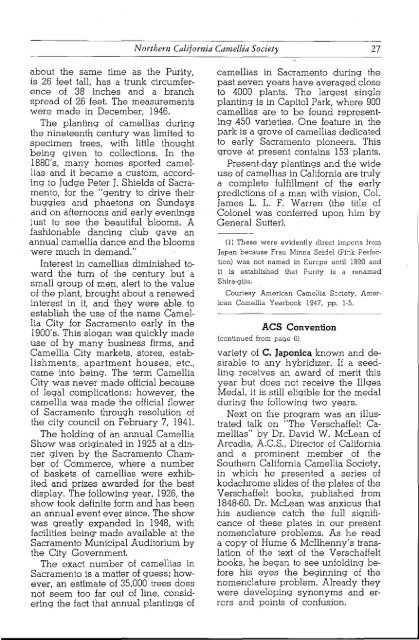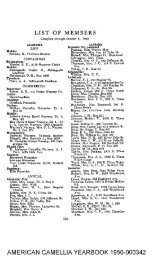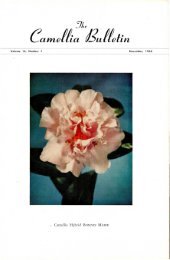CAMELLIA JAPONICA - GOVERNOR EARL WARREN - Immense ...
CAMELLIA JAPONICA - GOVERNOR EARL WARREN - Immense ...
CAMELLIA JAPONICA - GOVERNOR EARL WARREN - Immense ...
You also want an ePaper? Increase the reach of your titles
YUMPU automatically turns print PDFs into web optimized ePapers that Google loves.
about the same time as the Purity,<br />
is 26 feet talL has a trunk circumference<br />
of 38 inches and a branch<br />
spread of 26 feet. The measurements<br />
were made in December, 1946.<br />
The planting of camellias during<br />
the nineteenth century was limited to<br />
specimen trees, with little thought<br />
being given to collections. In the<br />
1880's, many homes sported camellias<br />
and it became a custom, according<br />
to Judge Peter J. Shields of Sacramento,<br />
for the "gentry to drive their<br />
buggies and phaetons on Sundays<br />
and on afternoons and early evenings<br />
just to see the beautiful blooms. A<br />
fashionable dancing club gave an<br />
annual camellia dance and the blooms<br />
were much in demand."<br />
Interest in camellias diminished toward<br />
the turn of the century but a<br />
small group of men, alert to the value<br />
of the plant, brought about a renewed<br />
interest in it, and they were able to<br />
establish the use of the name Camellia<br />
City for Sacramento early in the<br />
1900's. This slogan was quickly made<br />
use of by many business firms, and<br />
Camellia City markets, stores, establishments,<br />
apartment houses, etc.,<br />
came into being. The term Camellia<br />
City was never made official because<br />
of legal complications; however, the<br />
camellia was made the official flower<br />
of Sacramento through resolution of<br />
the city council on February 7, 1941.<br />
The holding of an annual Camellia<br />
Show was originated in 1925 at a dinner<br />
given by the Sacramento Chamber<br />
of Commerce, where a number<br />
of baskets of camellias were exhibited<br />
and prizes awarded for the best<br />
display. The following year, 1926, the<br />
show took definite form and has been<br />
an annual event ever since. The show<br />
was greatly expanded in 1948, with<br />
facilities being- made available at the<br />
Sacramento Municipal Auditorium by<br />
the City Government.<br />
The exact number of camellias in<br />
Sacramento is a matter of guess; however,<br />
an estimate of 35,000 trees does<br />
not seem too far out of line, considering<br />
the fact that annual plantings of<br />
Northern California Camellia Society 27<br />
camellias in Sacramento during the<br />
past seven years have averaged close<br />
to 4000 plants. The largest single<br />
planting is in Capitol Park, where 900<br />
camellias are to be found representing<br />
450 varieties. One feature in the<br />
park is a grove of camellias dedicated<br />
to early Sacramento pioneers. This<br />
grove at present contains 153 plants.<br />
Present-day plantings and the wide<br />
use of camellias in California are truly<br />
a complete fulfillment of the early<br />
predictions of a man with vision, Col.<br />
James L. L. F. Warren (the title of<br />
Colonel was conferred upon him by<br />
General Sutter).<br />
(1) These were evidently direct impcrts from<br />
Japan because Frau Minna Seidel (Pbk Perfection)<br />
was not named in Eurcpe until 1890 and<br />
it is established that Furity is a renamed<br />
Shira-giju.<br />
Courtesy American Camellia Scciety, American<br />
Camellia Yearbook 1947, pp. 1-5.<br />
ACS Convention<br />
(continued from page 6)<br />
variety of C. Japonica known and desirable<br />
to any hybridizer. If a seedling<br />
receives an award of merit this<br />
year but does not receive the Illges<br />
MedaL it is still eligible for the medal<br />
during the following two years.<br />
Next on the program was an illustrated<br />
talk on "The Verschaffelt Camellias"<br />
by Dr. David W. McLean of<br />
Arcadia, A.C.S., Director of California<br />
and a prominent member of the<br />
Southern California Camellia Society,<br />
in which he presented a series of<br />
kodachrome slides of the plates of the<br />
Verschaffelt books, published from<br />
1848-60. Dr. McLean was anxious that<br />
his audience catch the full significance<br />
of these plates in our present<br />
nomenclature problems. As he read<br />
a copy of Hume & McIlhenny's translation<br />
of the text of the Verschaffelt<br />
books, he began to see unfolding before<br />
his eyes the beginning of the<br />
nomenclature problem. Already they<br />
were developing synonyms and errors<br />
and points of confusion.




